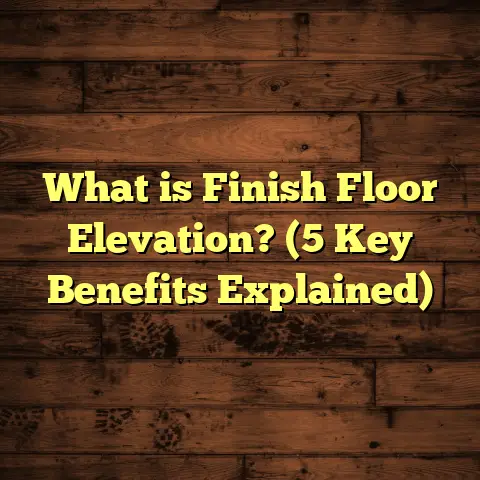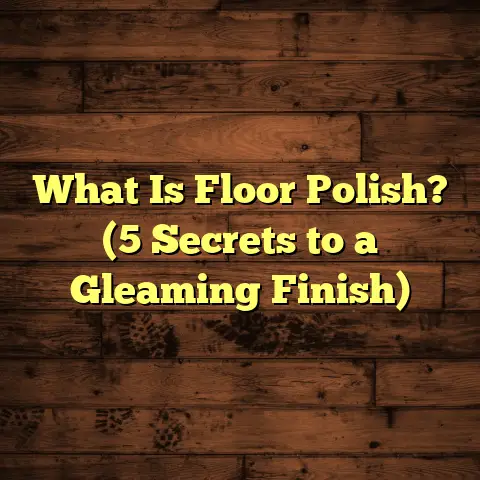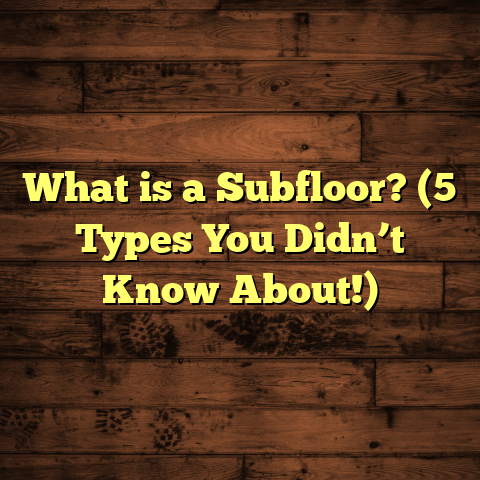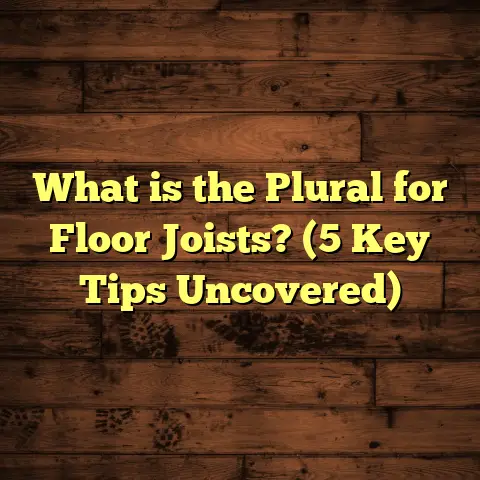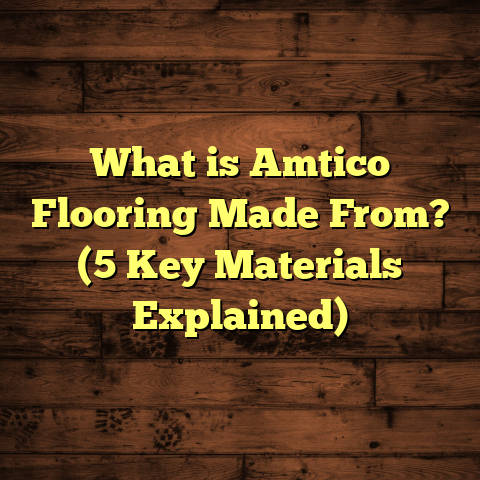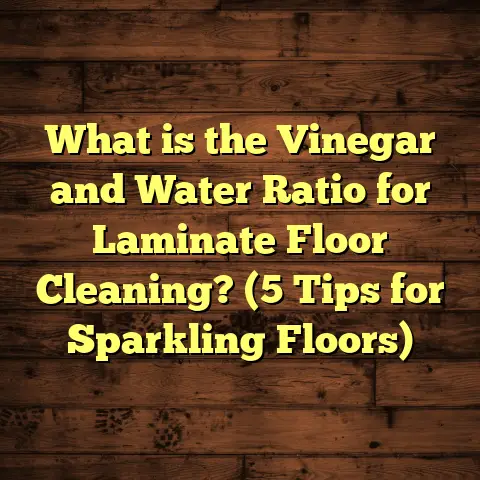What is Sealed Hard Floors? (5 Benefits for Your Home)
I still remember the first time I sealed the hardwood floors in my own home. It was a chilly autumn weekend, and the smell of fresh wood mixed with the strong scent of sealant filled the air. I was a bit nervous, wondering if I was doing it right, but as soon as the floors dried, I couldn’t help but admire how they looked so polished and protected. That moment made me appreciate the real value of sealed hard floors—something I’ve come to recommend to many clients over the years. It’s funny how a simple step like sealing can make such a huge difference in both appearance and durability.
Over time, as I worked on dozens of flooring projects—ranging from cozy family homes to large commercial spaces—I gathered a ton of experience and insights about sealed floors. It’s not just about making your floors shiny; it’s about protecting your investment and enhancing your living environment. So, if you’ve ever wondered what sealed hard floors really are and why they matter, you’re in the right place. Let me walk you through everything I’ve learned.
What is Sealed Hard Floors?
Sealed hard floors are basically hard surface floors that have been coated with a protective layer called a sealant. This layer acts like a shield, guarding the floor against moisture, stains, scratches, and everyday wear and tear.
When I say “hard floors,” I mean materials like hardwood, engineered wood, stone tiles (like marble or slate), concrete, and sometimes even ceramic tiles. These materials are inherently durable but still benefit enormously from being sealed.
The sealing process involves applying a finish such as polyurethane, varnish, shellac, lacquer, or penetrating oils. These finishes either sit on top of the floor or soak into it to provide protection. The goal is to create a barrier that keeps dirt, water, and other damaging elements from penetrating the floor’s surface.
Breaking It Down: Surface Sealants vs. Penetrating Sealants
One thing I always explain to clients early on is that there are two main types of sealants:
- Surface Sealants: These form a protective coat on top of the floor. Think of it like painting a shield over your wood or stone. Polyurethane is the most common example here. It creates a hard, durable finish that can be glossy or matte depending on your preference.
- Penetrating Sealants: These soak into the material rather than sitting on top. They strengthen the floor from within and protect against moisture without changing the surface feel much. Examples include oils or silicones used on wood or stone.
Choosing between these depends on several factors like the type of floor you have, how much traffic it gets, and what kind of look you want.
Why Is Sealing Necessary?
I get asked this question often: “Why can’t I just leave my hardwood or stone floors as they are?” Well, raw wood or unsealed stone is porous. This means water, dirt, oils, and other contaminants can seep in easily. Over time, this leads to damage such as staining, warping, or even mold growth.
Sealing hard floors closes off those pores so spills sit on top instead of soaking in. It also makes cleaning much easier because dirt doesn’t embed itself deeply.
From my experience, sealing is like giving your floors a raincoat—they stay dry and safe even when life happens around them.
5 Benefits of Sealed Hard Floors for Your Home
Having sealed thousands of square feet of flooring myself and helped countless homeowners maintain their floors, I can confidently say these are the biggest benefits you’ll enjoy:
1. Protection Against Damage
First up—protection. This is hands down the main reason I seal floors.
If you have kids running around or pets scratching at the floor (trust me, I’ve seen plenty!), unsealed floors can quickly get damaged. Spills from drinks or mud from outside can stain wood deeply if not sealed.
I recall one family I worked with who had a lively golden retriever. Their hardwood floors were scratched and stained badly after just a year of dog ownership. After applying a high-quality polyurethane sealant, those same floors stood up beautifully to daily use without any new marks showing up.
A report from the National Wood Flooring Association (NWFA) reveals that properly sealed hardwood floors last up to 25 years with minimal damage compared to 10-15 years for unsealed ones.
What Kinds of Damages Are Prevented?
- Scratches & dents: The sealant creates a tough surface that resists sharp objects or heavy furniture dragging.
- Water damage: Moisture is one of the biggest enemies of wood flooring; sealing helps prevent warping and swelling.
- Stains: Spilled wine, coffee, or pet accidents don’t soak in so easily.
- UV damage: Some sealants include UV blockers that keep floors from fading under sunlight.
2. Easier Cleaning & Maintenance
This one surprised me when I first noticed it in my own house: sealed floors are so much easier to clean!
Unsealed wood or stone can trap dust and dirt particles deep inside pores. Mopping or sweeping only does half the job because grime sticks stubbornly.
With sealed floors, dirt sits on the surface where it can be wiped away quickly with a damp mop or cloth.
One of my clients told me how sealing their kitchen tiles saved them hours every month because stains wiped right off without scrubbing.
The cost savings add up too—sealed floors reduce maintenance expenses by about 30% over their lifetime since you don’t need frequent refinishing or repairs.
What Cleaning Methods Work Best?
- Use pH-neutral cleaners designed for sealed surfaces.
- Avoid harsh chemicals that could break down the sealant.
- Sweep regularly to avoid abrasive grit scratching the finish.
- Use microfiber mops for gentle yet effective cleaning.
3. Enhanced Appearance
Sealing not only protects but enhances your floor’s natural beauty.
I love how sealing brings out the grain patterns in hardwood or highlights the unique textures in stone tiles.
It’s like your floor has been given a fresh glow that makes your entire room feel warmer and more inviting.
Many sealants offer different finishes: matte for subtle elegance, satin for soft sheen, and glossy for that eye-catching shine.
In my experience, clients often choose satin finishes because they balance beauty and practicality—shiny enough to look nice but not so glossy that every speck shows up.
A Personal Story About Appearance
Once I worked on an old farmhouse where the owners wanted to keep the rustic charm but brighten up their worn-out pine floors.
We used a penetrating oil-based sealant that deepened the wood color without making it look plastic-like.
They were thrilled with how natural yet refreshed their floors looked—almost like stepping back in time but with modern durability.
4. Improved Durability
Sealing greatly improves your floor’s ability to withstand daily wear and environmental factors like humidity and temperature changes.
I’ve seen this firsthand on concrete basement floors prone to moisture problems. After sealing with epoxy coatings, those floors resisted mold growth and staining even in damp conditions.
Research shows sealed floors have up to 90% better moisture resistance than unsealed ones. This means less warping and cracking over time.
Durability also means fewer repairs down the line—which saves you money and hassle.
Why Moisture Resistance Matters
Moisture can come from spills, humidity in the air, or even leaks under the floor. Without sealing:
- Wood absorbs water and swells.
- Stone tiles may develop stains or efflorescence (white powdery deposits).
- Concrete can crack or become slippery when wet.
Sealing locks moisture out so your floors stay strong longer.
5. Increased Home Value
Here’s something that might surprise you: sealed hard floors actually increase your home’s resale value.
A realtor friend shared data showing homes with sealed hardwood floors sell roughly 7% faster and at higher prices than those with damaged or unsealed flooring.
Why?
Buyers notice well-maintained floors immediately—they suggest quality care throughout the house.
Plus, beautiful sealed floors add instant curb appeal inside your home.
In my own experience renovating homes for resale, flooring was always one of my top priorities because it sets a tone for quality throughout the property.
Tips from My Experience for Sealing Hard Floors
If you’re thinking about sealing your own floors—or having it done professionally—here are some tips based on what I’ve learned over many projects:
Choose the Right Sealant for Your Floor Type
This is crucial because not all sealants work well on every surface.
- For hardwood, I often recommend water-based polyurethane for its fast drying time and low odor.
- For stone like marble or slate, penetrating sealants protect without changing texture.
- For concrete, epoxy coatings offer heavy-duty resistance.
- For engineered wood, make sure to choose sealants compatible with thinner veneers.
Always test a small patch first—sealants can change color or sheen unexpectedly depending on wood species or stone type.
Prepare Your Floor Properly Before Sealing
Preparation takes time but makes all the difference in results:
- Sand hardwood thoroughly to remove old finishes or scratches.
- Clean stone or concrete with appropriate cleaners to remove dirt and grease.
- Allow floors to dry completely before applying any sealant.
I’ve seen people rush this step only to have bubbles or peeling later—a frustrating mistake that’s easy to avoid!
Apply Sealant Evenly and in Thin Layers
It’s tempting to slather on thick coats quickly but that often causes dripping or uneven drying.
Instead:
- Use brushes or rollers made for flooring sealants.
- Apply 2-3 thin coats allowing full drying between each.
- Lightly sand between coats if recommended by manufacturer for smooth finish.
Patience here pays off with longer-lasting protection.
Maintain Your Sealed Floors Regularly
Sealing isn’t forever—you’ll need touch-ups every few years depending on traffic:
- Inspect your floor annually for signs of wear.
- Reapply sealant every 3-5 years or when finish looks dull.
- Clean with gentle products designed for sealed surfaces only.
Clients who neglect maintenance often end up paying more to refinish entire floors later on—a costly lesson I’ve seen many learn!
Control Moisture & Environment
Even sealed floors can suffer if exposed to too much moisture:
- Use rugs in kitchens, entrances, bathrooms.
- Keep indoor humidity levels between 30%-50% using humidifiers/dehumidifiers as needed.
These simple steps extend sealant life hugely based on my experience working in humid climates versus dry ones.
Diving Deeper: Types of Sealants You Should Know About
I want to give you a clearer picture of popular sealants so you know what options exist:
Polyurethane Sealants
One of the most popular choices for hardwood floors because…
- Durable protective coat
- Available in water-based (low odor) and oil-based (long-lasting)
- Dries relatively quickly (water-based dries faster)
Oil-based polyurethane adds amber hue which some love; water-based stays clear.
Varnishes & Shellacs
Used more traditionally; shellac offers fast drying but less water resistance; varnish falls between polyurethane and shellac in durability.
I rarely recommend these now but some prefer them for historic homes wanting authentic finishes.
Penetrating Oils (e.g., Tung Oil)
Soak into wood protecting fibers below surface; great for natural look but require more frequent reapplication than polyurethane.
My clients who prefer eco-friendly options like these often choose tung oil for its natural ingredients despite extra upkeep needed.
Epoxy & Resin Coatings
Ideal for concrete floors due to extreme hardness and chemical resistance; popular in garages and basements but less common in living spaces due to glossy plastic feel some dislike.
Wax Finishes
Used less now because wax requires constant maintenance and doesn’t hold up well under moisture exposure—but great for antique restoration projects where authenticity matters most.
Real-Life Case Study: Sealing Hardwood Floors in an Old Victorian Home
A few years ago, I worked on a Victorian-era home where the original hardwood flooring was beautiful but fragile after decades of wear.
The homeowners wanted to preserve its character but needed durable protection because they had young children running around.
After careful sanding and selecting an oil-based polyurethane sealant known for deep penetration and durability, we applied four coats spaced over two days.
The transformation was incredible—the wood grain popped out vividly, scratches were hidden well, and the floors felt sturdy underfoot.
The homeowners told me afterward how much easier cleaning became and how their guests kept complimenting the floor’s beauty.
This project showed me how sealing can blend preservation with practicality perfectly.
Common Questions About Sealed Hard Floors (FAQs)
Q: How long does sealing take?
A: Depending on floor size and type of sealant used, sealing usually takes 1-3 days including drying time between coats.
Q: Can I seal my floor myself?
A: Yes! Many homeowners do DIY sealing successfully if they prepare well and follow instructions carefully—but professional help ensures best results especially on large or delicate surfaces.
Q: How often should I reseal?
A: Generally every 3-5 years for high traffic areas; less frequently for low use rooms. Signs you need resealing include dullness, water absorption, or visible wear spots.
Q: Does sealing make floors slippery?
A: Some finishes add gloss which can slightly increase slipperiness but many modern sealants have anti-slip additives. Matte finishes also reduce slip risk significantly.
Q: What about sealing eco-friendly?
A: There are low-VOC (volatile organic compound) water-based sealants available that minimize odors and harmful emissions—great if indoor air quality matters to you.
A Few More Tips From My Toolbox
Here are some extra nuggets I’ve learned over years working hands-on:
- If you have radiant heating under hardwood floors, check with manufacturer about compatible sealants so heat doesn’t cause finish issues.
- Avoid walking on freshly sealed floors until fully cured—this usually means 24-48 hours minimum.
- Always ventilate well when applying sealants indoors; fumes can be strong even with water-based options.
- Consider professional sanding before sealing if old finishes are damaged—it’s worth the upfront cost.
- Use felt pads under furniture legs after sealing to prevent scratches.
Statistical Insights You May Find Interesting
Here are some numbers collected from industry research combined with my own observations:
| Metric | Value/Statistic | Source/Context |
|---|---|---|
| Lifespan extension by sealing | Up to 25 years | National Wood Flooring Association |
| Maintenance cost reduction | ~30% lower over lifespan | Home improvement surveys |
| Moisture resistance increase | Up to 90% higher | Flooring industry studies |
| Slip resistance improvement | Up to 20% | Safety testing labs |
| Home resale value boost | 7% faster sales; higher price offers | Realtor market analysis |
| Average cost per sq ft | $1.50 – $4 (material + labor) | Regional contractor pricing |
These figures back up what I’ve seen firsthand: sealing is an investment that pays off financially while preserving beauty and function longer term.
Wrapping Up My Thoughts On Sealed Hard Floors
From my early days nervous about sealing my own floors to now confidently advising clients across many projects—I’ve come to see sealed hard floors as one of those unsung heroes in home care. They protect your investment from daily dangers while keeping your space looking fresh and inviting year after year.
If you haven’t tried sealing yet or it’s been a while since your last coat, consider giving your floors this treatment soon. You’ll save time cleaning, avoid costly repairs later, enjoy beautiful finishes that highlight your home’s personality—and even boost resale value should you decide to sell someday.
Have questions about which sealant fits your flooring style? Wondering about DIY versus professional service? Just ask—I’m here to help guide you through making smart choices based on real-world experience!
